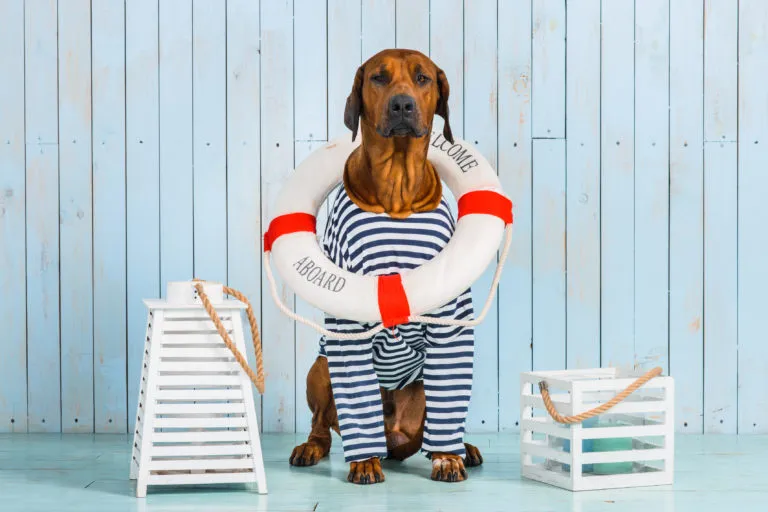Be it by train, car or even ship, more and more dog owners are enjoying the opportunity to take their dogs with them on holiday. A water crossing can be on the agenda even for short Sunday excursions. From rowing boats to small ferries and cruise ships, there are many situations that can mean “ship ahoy!” for dogs. In the following article, we will give you tips on how you and your canine companion can enjoy a relaxed journey on board a ship.
With dogs on the high seas
Aspiring sea dogs need early practise
Before you plan a short or longer boat journey with your dog, you’re best off carrying out a few small tours on the water. For instance, observe whether your dog appears relaxed and remains in shape on a short journey across a lake, river or a ferry crossing. In most cases there are no health issues, but as with some humans, a very small percentage of dogs can end up seasick. The smaller the boat, the more difficult it will be for such dogs, so you should spare them sea voyages where possible. In straightforward cases, reducing the amount of food should help in the short-term. Practice climbing different forms of steps as preparation too – the steps on boats are really tricky for some dogs because they can see to the bottom. Use accessible landing stages too as practise in order to get your dog used to swaying surfaces.
Full steam ahead!
For short crossings it’s no problem if your canine travel companion has to stay in the car, which is the case with many shipping companies. When it comes to journeys lasting longer than six hours, you should thoroughly research in advance whether there are other alternatives for the crossing. If your dog can come on deck with you, there’s often an area available for long journeys where it can do its business, though this is usually very dirty and not all dogs will be willing to make use of it. This is an advantage for those who’ve trained their dog to do its business on command. In any case, equip yourself with kitchen roll and poop bags to be on the safe side in order to easily clear away any little accidents.
On an even keel with houseboats
Do you want to take your dog on holiday on a houseboat? Go for it! Dogs generally enjoy being part of these comfortable trips, especially water lovers that often have the opportunity to go swimming. You should of course regularly give your four-legged travel companion the opportunity to go for a walk on land so that it gets tired out and can deal with all its “important business”. It can be helpful to train your dog to use a specific place on board to urinate and defecate. Whilst your dog won’t eat much before or during the journey, it should drink a lot.
Some dogs also have fun accompanying their owners on rowing or sailing tours. The wobbly surface can often be irritating at the beginning, but your dog will mainly enjoy its adventure on the waves once it has got used to this sensation. On tours for which humans are required to wear a life jacket, you should put one on your dog too to be on the safe side. In addition, your travel companion should be able to swim well and be retrievable during this time – you’re best off practicing this extensively beforehand. Naturally it’s important that your dog learns before going on boat tours that it does has to stay inside the boat and not make quick breakaways to hunt ducks. Excursions shouldn’t last longer than a day, by which time you’ll be ready for shore leave!
Cruises ships: on very high seas
There are now more and more shipping companies offering animal-friendly cruises that welcome dogs. Carry out precise research into the requirements beforehand and the mainly strict hygiene regulations on a cruise ship. For instance, furry friends are generally taboo in the on-board restaurant and many other areas. If you’ve decided on the trip, book as soon as possible, because the number of cabins for dog owners is very low. There are exceptions for guide dogs, which receive special permission for cruise ships at short notice too. Also, check in good time whether your four-legged travel companion meets all the requirements for accompanying you on a cruise ship. It will generally need a microchip, rabies vaccination, EU pet passport and current tick and tapeworm treatment.
You shouldn’t just adhere to the formalities, but also critically question whether your dog is inherently suited for travelling by ship. It shouldn’t have any problems climbing ramps or encountering other people or possibly dogs in narrow areas and all in all, should be very well trained and relaxed. A leash is required on the ship. In addition, not all shipping companies allow dogs to stay in a cabin – they are accommodated in a special area or in boxes on deck on some ships. Consider in depth beforehand whether you wish to subject your dog to this. Take advantage of land tours to get to know the area with your dog, but consider beforehand that quarantine conditions could vary depending on the country in question. In many cases, a better solution may be for your dog to stay at home in the safe hands of family members or a trusted dog sitter.
We wish you and your dog lots of fun and relaxed journeys on all waters!
